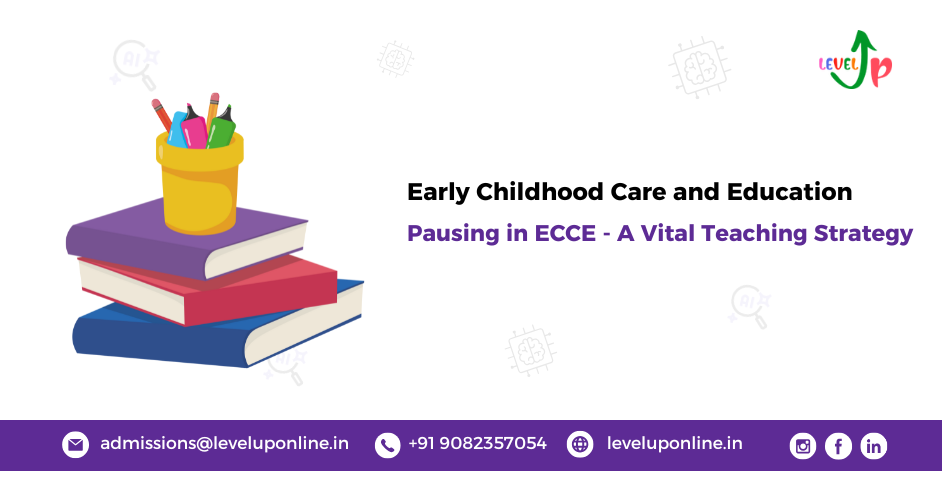Introduction
In Early Childhood Care and Education (ECCE), the concept of pausing in ECCE is more than a reflective practice — it is a pedagogical strategy grounded in neuroscience, communication theory, and child development research. As educators navigate increasingly stimulus-rich environments, integrating intentional silence becomes an act of both curricular depth and developmental necessity.
1. Pausing Enhances Working Memory Consolidation
One of the core reasons to advocate for pausing in ECCE is its direct link to memory consolidation. Cognitive Load Theory (Sweller, 1988) suggests that when too much information is presented too quickly, learners—especially young ones—fail to process or retain it. Intentional pauses allow working memory to offload and integrate new information, increasing the likelihood of long-term retention.
❝ In simple terms: young brains need “mental space” to sort what they’ve learned. Without it, even meaningful experiences get lost in cognitive noise. ❞
2. Silence Promotes Executive Function Development
Executive functions—such as inhibitory control, cognitive flexibility, and emotional regulation—are formed rapidly in the early years. Research from Harvard’s Center on the Developing Child indicates that these skills are best developed when children have moments to pause, reflect, and decide.
By embracing pausing in ECCE, educators offer children not only behavioral scaffolds but mental clarity to manage their emotional worlds. A well-timed pause gives children:
1. Time to choose (rather than react)
2. Space to regulate (rather than meltdown)
3. Freedom to create (rather than imitate)
3. Pausing Improves Language Processing and Comprehension
In early language acquisition, “wait time” is critical. According to Rowe & Snow (2019), children exposed to more “conversational turns”—which include pauses for child responses—develop more robust vocabulary and comprehension skills.
This is why pausing in ECCE settings, especially during dialogues, plays a critical role in enhancing language development.
Fast-paced talk = Passive listening
Paced conversation = Active participation
A pause after a question gives the child permission to think, imagine, and formulate. It respects their developmental pace.
4. Pausing Builds Social Reciprocity and Empathy
The Theory of Mind (ToM)—the ability to understand others’ feelings and thoughts—begins developing around ages 3–5. Educators who pause and reflect instead of responding immediately model reciprocal communication and empathic responsiveness.
❝ When we pause, we listen not just to words but to intent, context, and emotion. This models a culture of care. ❞
Ultimately, pausing in ECCE models respectful communication and supports the child’s social-emotional growth.
5. Pausing Challenges the “Busy Equals Learning” Myth
In ECCE, productivity is often equated with noise and visible activity. But high-quality learning environments are not always bustling. Often, they are thoughtfully slow, rhythmically paced, and sensitively tuned to each child’s tempo.
Quiet time and pausing in ECCE challenge the high-speed model of productivity and redefine what effective learning looks like.
Intentional silence breaks the pattern of constant output and invites:
1. Deep play
2. Self-initiated exploration
3. Focused observation by educators
This reflects a Reggio Emilia-inspired approach, where the environment (and silence within it) is considered the “third teacher.”
6. Practical Implementation of Pausing as a Teaching Strategy
To successfully integrate pausing in ECCE, educators must be intentional, not incidental, with silence. They can structure pause moments within daily routines without disrupting flow:
| Activity | Intentional Pause Point | Why It Works | |
| Storytelling | Pause before turning each page | Builds anticipation and improves narrative prediction | |
| Circle time | One minute of quiet breathing before starting | Recenters group energy | |
| Questioning | 5–10 seconds after an open-ended question | Encourages deeper thinking, supports slower processors | |
| Conflict | Pause before intervening | Models of self-regulation allow for peer resolution | |
7. Inclusive Education: Silence as a Sensory Accommodation
For neurodiverse learners, especially those with Autism Spectrum Disorder (ASD) or Sensory Processing Disorder (SPD), silence is not a void — it is regulation.
Pausing in ECCE classrooms creates a flexible learning environment that caters to sensory and processing needs. Sometimes, the best support is not about adding stimulation but reducing it.
Pausing helps:
1. Lower auditory overload
2. Provide processing time
3. Signal emotional safety
This aligns with Universal Design for Learning (UDL), which promotes varied ways to engage and express.
8. Addressing Educator Resistance to Pausing
Some educators resist silence, fearing it signals disengagement or lack of control. But pausing in ECCE is not a gap in teaching — it is a vital part of it.
With consistent training and mindset shifts, pausing in ECCE can become a transformative tool rather than a perceived disruption. Educators can:
1. Use visual timers to normalize quiet reflection
2. Co-regulate with children (pause and breathe together)
3. Document what emerges after a pause (deep insights, better focus)
Professional development should address silence not only as classroom management but as instructional design.
Conclusion: Silence as a Scaffold, Not a Stop
Silence, when intentional and purposeful, acts as a scaffold for deeper learning. In ECCE, pausing in ECCE allows for a pedagogical shift — from managing children to mentoring them. It transforms the classroom from a space of constant instruction to one of shared discovery.
In a world obsessed with speed, pausing in ECCE reminds us that real growth takes time — and often, it happens quietly.


